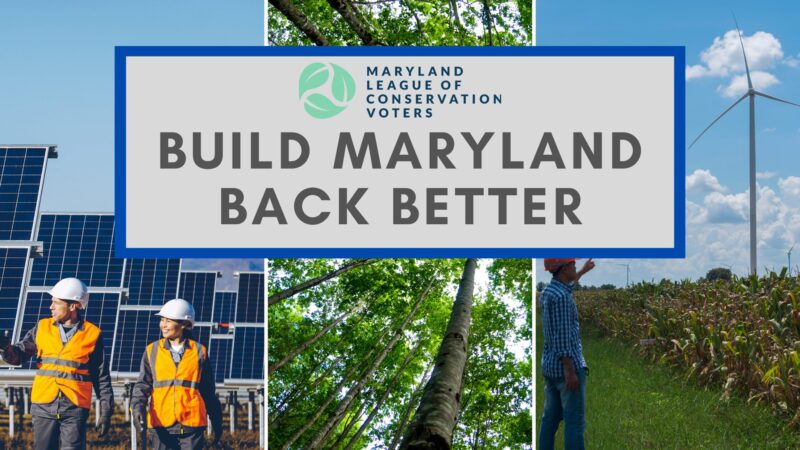 By Jason Aul, Strategic Communications Director – The Moore Administration released Maryland’s Climate Pollution Reduction Plan, as required by the 2022 Climate Solutions Now Act, to reduce greenhouse gas emissions 60% by 2031.
By Jason Aul, Strategic Communications Director – The Moore Administration released Maryland’s Climate Pollution Reduction Plan, as required by the 2022 Climate Solutions Now Act, to reduce greenhouse gas emissions 60% by 2031.
The Maryland League of Conservation Voters (Maryland LCV) applauds the Maryland Department of Environment (MDE) for their timely and comprehensive report, and establishing a strong policy foundation for Maryland to meet its climate targets, however is disappointed the plan does not commit to funding the implementation of the policies.
The plan’s inclusion of policies such as addressing energy efficiency in buildings, updating appliance standards, excluding municipal waste incineration from the state’s Renewable Energy Portfolio Standard (RPS), and developing a new Clean Power Standard is particularly encouraging. The plan clearly lays out the steps and actions needed to meet Maryland’s climate goals.
Maryland LCV Executive Director, Kim Coble, issued the following statement on the plan’s release:
- “We commend the Maryland Department of the Environment for the tremendous effort to complete this report in the timeline required. We are encouraged by many of the proposals in the plan, but also recognize where it falls short. Most importantly, the plan does not include a funding mechanism to implement the infrastructure and policies required for the transition to clean, renewable energy and ensure low income households are not left behind in the transition. We will continue to work with the administration and the Maryland General Assembly to ensure there are adequate resources and a regulatory framework to meet the moment.”
The Moore Administration and the Maryland General Assembly (MGA) need to move forward swiftly with proposals and policies that do not require new funding sources, including;
- Removing manufacturing exemption from state GHG accounting
- Removing municipal waste incineration from the state’s RPS
- Shifting the goals of the state’s energy efficiency program
- Reducing the total vehicle miles traveled across the state
The plan falls short in three key areas. If Maryland is going to be a national leader on fighting climate change impacts, the Administration need to address the following:
- Establish a Robust Funding Mechanism: Create a funding mechanism that will leverage private funds and provide the estimated $1 Billion a year needed to achieve Maryland’s 2031 emissions reduction goal. New York, Washington, and California are moving in this direction and surprisingly, Michigan is also leading the country in not only creating a plan to address climate change but also identifying and providing funds to implement the plan. Without designated funding, or even a commitment to finding funds, there is no guarantee the policies will be implemented and the plan is simply – a plan.
- Urgent Renewable Energy Deployment: If Maryland is going to meet the 100% Clean Energy goal, leadership is needed to ensure Maryland’s renewable energy sources including wind, geothermal, and in particular solar are deployed immediately and with urgency.
- Addressing Environmental Justice: Addressing the impact of pollution and climate change on underserved and overburdened communities, who often include those who contribute the least to the problems, needs to be a top priority. Actions including job training and a just transition for those needing to change jobs or have been left behind in other economy-wide changes need to be prioritized in the plan. Additionally, funding is needed to keep communities from falling behind in the transition, including retrofitting low and moderate income homes and making the leap to electric vehicles. Investing in renewable, clean energy today means an investment in jobs, health, and the environment for decades to come.
The Governor and his administration can maintain their commitment to fighting climate change by issuing an executive order accompanying the plan that:
- Provides steps to develop specific and concrete funding mechanisms for the plan
- Outlines and prioritizes a climate focused 2024 legislative agenda
- Establishes regulations and actions that can be implemented immediately
By taking these actions, the Moore administration will reinforce its commitment to environmental stewardship while also ensuring Maryland continues to be a national leader in climate action. Maryland LCV remains committed to working alongside the Administration and state leaders to realize a sustainable and equitable climate future for everyone in Maryland.



